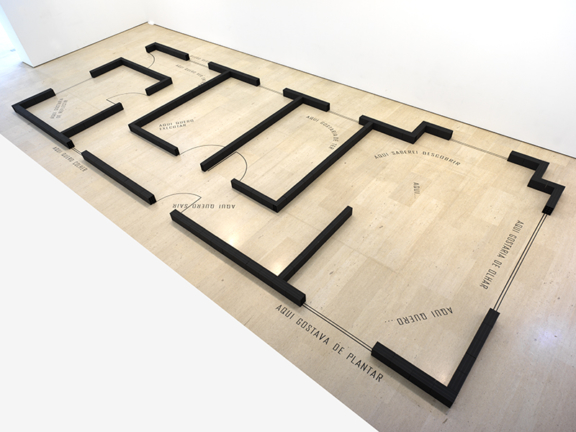
Ana Vieira
Ocultação/Desocultação
Coimbra, Portugal, 1940 – Lisbon, Portugal, 2016
Ana Vieira was studying painting, when she began veering away from it – not only did she consider herself unskilful, but she also felt that the pictorial medium was undermining her artistic expression. Ana Vieira started to exhibit early on, and the title of her first solo show, Imagens Ausentes [Absent Images] (Galeria Quadrante, Lisbon, 1968), already made clear that, though the tyranny of the canvas was overcome, she would carry on working within the domain of the image – but necessarily in an experimental way. Still in the 1960s, Ana Vieira showed profiles and cuttings of objects and figures, whose mimetic renderings are nonetheless illusory, because even though they might be identified, they are but an outline of forms that are empty on the inside, that are absent. From this moment on, she conceives her works as intentional “simulacrums” of the things they depict. In her work, Ana Vieira mainly chose objects of domestic usage, such as furnishing pieces (tables, cupboards, consoles, mirrors) in wood, later homogenized by industrial paint. Her figures are also devoid of identity, in successive silhouettes and outlines of human busts, but also in the profiles of full bodies in motion or in tension, drawn on screens and surfaces.
From the 1970s onwards, such post-pictorial recreation of common objects led Ana Vieira to prefer installations as the preferred artistic mode and to ground the territory of her work in the semiotics of physical and social spaces. The conception of sceneries appeared as a possibility to build an open work, through which the artist breached the divisions between painting and sculpture, and conceived works according to the surrounding space with which they communicate. When Ana Vieira first showed her environments, already in 1971 and 1972, she rose to a prominent place in Portugal’s artistic avant-garde, having participated in that decade’s seminal exhibition, Alternativa Zero [Zero Alternative] (1977). With these installations, conceived as inhabitable places that re-enact houses and their subsequent domestic rituals, Ana Vieira’s simulacrums thus reached far broader ranges and meanings, finding a focus on the intimacy and memory preserved by private spaces. And with the evolution of such a highly symbolic language also came the proliferation of household items such as tables, windows, doors, chairs.
However, despite the spotless formal simplicity of Ana Vieira’s works, recalling the shadows of Lourdes Castro or Michelangelo Pistoletto’s mirrors, our visual perception of theirs spaces is troubled by the play of transparencies, veils, screens, nets and webs which involve them. The onlooker ends up in the role of a voyeur, trying to capture the interior of her environments through door slits and peepholes. Most of her works are not seen, but rather peeked at, a tension avowed by the title of Ana Vieira’s longest lasting project, Ocultação / Desocultação [Hide / Unhide] (1978-2009). The physical and visual impenetrability of her private spaces deliberately restate the divide between art and life, in installations that are as much about seeing as they are about living.
The appeal of scenography also pushed Ana Vieira to more diverse experiences, such as the creation of sets and figurines for theatre (plays by Adolfo Gutkin, Bertolt Brecht and Jean-Paul Sartre), projects to reconfigure sites, houses and landscapes, or site-specific pieces for museums. But, most importantly, the artistic practice of installations and the manipulation of three-dimensional objects is still cultivated in her work, prompted by poetical claims not far from those that first fueled her work back in the mid-1960s. In consideration of this cohesive career, which has been under continuous renovation in the solo shows being presented along the years, Ana Vieira received the Portuguese art critics award, the AICA/SEC (1991), and the Serralves Foundation in Porto hosted her first anthological exhibition. Between 2010 and 2011, the Centre of Modern Art, in collaboration with the Carlos Machado Museum in Ponta Delgada (Azores), showcased the artist’s largest retrospective to date.
Afonso Ramos
April 2011